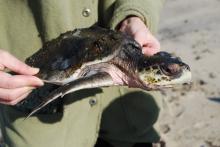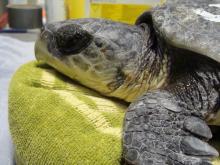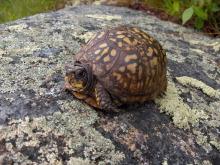The Island’s oldest resident may well live in the woods of West Tisbury. Her name is Boxer.
Two nine-year-old girls have seen her. Lucy Hodgson and Amelia Krales saw the ancient woodland traveler at the start of the summer. The old lady was making her way down a narrow path in dense woods under dappled sunlight.
She is a very old box turtle.
Tom Hodgson, Lucy’s father, has read in science books that a box turtle can live for 130 years.
There is evidence on this turtle that it is at least that old.
On the bottom of its shell, a person named W.W. carved his initials and the date 1861. Another person named J.B.M. carved his initials and the date 1881.
Elmer (Mike) Athearn, 73, of Music street, thinks the turtle has been a highly regarded resident of his neighborhood for years.
“I do recall it. It must be the same turtle. Anthony T. Campbell, who lived in the house where Alex Taylor now lives, found the turtle. He found the turtle up in that area. He found it where Tom [Hodgson] lives.”
Mr. Campbell’s initials are also caved on the turtle: ATC 1932.
After a little checking around, Mr. Athearn may have an answer to the mystery behind two other signatures.
“I am sure that J.B.M. is Jerry B. Mayhew. He was a native who owned a farm up at the end of Music street.” The property today is the Dyes homestead.
The initials W.W. may belong to a soldier who fought in the Civil War.
“That was William West who lived up the street. He was a Civil War veteran.”
As to weather Mr. West carved his name on the turtle, Mr. Athearn said: “I wouldn’t stake my reputation on that.”
There are other initials carved on the six-inch long turtle: LPC, HHP 1955 and TAW.
Miss Krales had her own opinion about the carves. “It seemed mean that some one wrote on the turtle’s stomach.”
This is the second year that the two girls found the turtle. Miss Krales explained that the turtle was found this year on a path through the woods that runs between her summer home and the home of her closest friend, Miss Hodgson.
“I was planning on going to the beach with Lucy. I was on my way to her house when I found the turtle. When I saw it, it just stood there,” she said.
“We named it Boxer,” she said.
After photographing the turtle, they released it back into the woods.
Besides the signatures, the box turtle also has two small holes drilled in the edge of its shell.
Susan Whiting, a Vineyard naturalist, said that in the days before high tech toys, youngsters might have tied a little cart to the back of the turtle. That would explain the two holes. Miss Whiting, incidentally, said she believes the turtle is female.
Gus Ben David, directory of the Massachusetts Audubon Society’s Felix Neck Wildlife Sanctuary, hasn’t yet seen boxer. But he has seen many other box turtles across the Island.
Carving initials in turtles may have been accepted practice years ago. Mr. Ben David said: “I think that it was a prominent activity for young boys growing up on the Vineyard in the 1800s and early 1900s. In those days there were farm boys and farm girls. Box turtles were part of their lives. There were more of them. It was just like kids to carve their initials in a tree when they fall in love for the first time. It was part of a culture to carve dates on turtles. But it shouldn’t be done today.”
In those days there were many more box turtles than today. The advent of the automobile and rise in population have made the survival of the terrestrial turtle difficult.
“There used to be a good population of box turtles along the North Road,” Mr. Ben David said. “It is a good box turtle habitat. But compare the North Road in the 1950s to the way it is today. On a hot summer’s day years ago, when an animal crossed the road, there were only so many cars traveling that road per hour. Just think of a turtle trying to cross the road today. His chances are a hundred times greater that he will be killed.”
Mr. Ben David said: “Young box turtles have a tendency to hang around wetlands, but adults rarely go into the water. They feed on invertebrates, earthworms, slugs. They are also vegetarians, feeding on wild fruit and berries. They feed on mushrooms, wild raspberries and wild strawberries.”
Many times during the course of the summer, people approach Felix Neck asking how to care for a turtle. “I had a lady who found a box turtle in Dodger Hole just the other day ask me what to feed it. She was hedging on keeping it. Once I got through explaining that the turtle is a protected species, she agreed to release it.”
Mr. Ben David has advice for all young naturalists who find a box turtle.
“It is a plea. Don’t keep it out of the wild population. We don’t want to dampen that young child’s enthusiasm for wanting to keep a turtle. My advice to a parent faced with an eager child is maybe to keep the turtle for a week and enjoy it. But then put it back exactly where you found it,” Mr. Ben David said. “Box turtles are territorial. If you transport it to another part of the Island, it will spend the rest of its life trying to get back home.” And that is when it is most likely killed, he said.
Mr. Ben David said that any youngster who has an interest in seeing a box turtle first-hand should come to the sanctuary. “We have a legal pair of box turtles. Bring the kids out. We’ll let them take the turtle out on the grass.”
Mr. Ben David said: “There is a special concern in Massachusetts about the future of the box turtle.” Its numbers are dwindling.
Mr. Hodgson said: “I am no expert on box turtles, but I was under the impression that box turtles are usually found in open lands. But this turtle lives in a very wooded area. These woods are between 40 and 80 years old. The turtle probably grew up in brush land, but now it has become woods. It is a neat turtle.”
“There isn’t anything else that comes close to the age of a box turtle,” Mr. Ben David said. “They are the matriarch and patriarch of the animal world on Martha’s Vineyard.









Comments